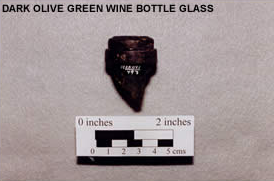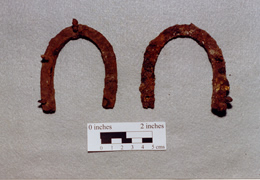The Basil Smith site contained many artifacts that help describe Anne Arundel County’s agricultural past. The oldest artifacts were found in Concentration 1 and they appear to be associated with Daniel Plummer’s prosperous late 18th to early 19th century farm.

Architectural artifacts indicate that a log or post in ground structure probably stood in this location, but the ceramic artifacts provided the most revealing clues about the wealth and household character associated with the structure. Daniel Plummer apparently indulged in some luxuries, such as smoking a pipe and drinking wine, as indicated by the recovery of wine bottle glass and kaolin pipe fragments. The small number of historic artifacts recovered from the excavations supports the historic record, which indicates that Daniel Plummer lived alone at this site until shortly before the time of his death.
Archeologists were not able to identify the occupants of the site after Daniel Plummer’s death, though they were able to glean some information about the site’s use. The occupants are believed to have been tenants, first of John and Martha Harmon, and then of Basil and F. Marion Smith. The tenants likely lived in the structure represented by the foundation. The size of the foundation – approximately 17 square feet – is consistent with the size of other tenant houses identified in the area.
The types of artifacts found near the foundation were not as old as those found in Concentration 1, and they did not reflect the prosperity enjoyed by Daniel Plummer. The artifacts collected indicate that the occupants were not wealthy. Although the structure would have been used during the time that truck farming became widespread in Anne Arundel County, the structure does not appear to have been a picker’s shed. Picker’s sheds served as dormitories for agricultural workers during the growing season. Historical accounts indicate that the picker’s sheds housed so many workers during warmer seasons that cleaning and cooking activities all took place scattered throughout the yard areas rather than inside. The artifacts were clustered near the foundation rather than scattered throughout the yard area, and included a clothing iron, scissors, and other household items that suggest a stable, year-round household. The foundation also had a fireplace, which indicates that cooking activities took place inside.
Although archaeologists hoped that artifacts recovered from the excavation might reveal information on the religious practices of the site occupants, not enough appropriate artifacts were recovered to discern religious heritage. However, the conveyance of property shown through MAA’s deed research reflects the general transition from Quaker to Methodist settlement.
Though the site occupants of this time period are not known, archaeologists found some evidence that they may have been African-American. Historically, there was a community of free blacks in the area dating to before the Civil War. There were also “colored schools” and AME churches such as Peter Gambrill’s in the immediate area. The pickers checks found in the foundation soil deposits belong to an African-American farmer, Noah Queen, indicating that the tenants of the Basil Smith Farm may have been workers on Noah Queen’s farm.
…The Stories They Tell

The archaeological excavation recovered many artifacts that reflect Anne Arundel County’s unique agricultural history. Agricultural activities, including participation in the truck farming industry in the 19th and early 20th centuries, drew workers from the city as well as tenant farmers to northwestern Anne Arundel County. The Benson Hammond House exhibits and recent publications, such as Will Mumford’s Strawberries, Peas, and Beans: Truck Farming in Anne Arundel County, vividly portray the immigrant and African American communities that participated in the truck farming industry in northwestern Anne Arundel County and the material remnants of this culture, such as the picker’s sheds and picker’s checks. The results of the archaeological excavations revealed evidence of the lives of past occupants of one farmstead that participated in truck farming. Specifically, the research and excavations conducted by MAA archaeologists revealed the following:
- The occupants of the Basil Smith site after Daniel Plummer’s death are not known, but they were likely tenants of the Harmons, and then the Smith family. The small foundation, cooking hearth, and the type and distribution of household artifacts indicate that the site was likely occupied year round.
- The site was probably not used much in the 20th century. If so, the inhabitants were likely poor. There is no indication that the structure represented by the foundation was equipped with electricity, gs, or plumbing.
- The artifacts recovered were consistent with the information learned during archival research, identifying the site as a farmstead occupied first by prosperous landowners and then by lower income tenant farmers.
- The artifacts recovered were not sufficient to identify the religious affiliation of any of the site occupants.
- The diet of the site occupants, as identified by recovered animal bones, indicates that later site occupants may have had low incomes. The bones reflect lower quality cuts of meat and opportunistic foods such as local game.
- The artifacts recovered (such as horseshoes and fragments of farm machinery) support the findings of the archival research that the site was farmed from the 18th to the 20th century, and its occupants participated in regional agricultural trends such as the truck farming industry in the 19th and 20th centuries.

